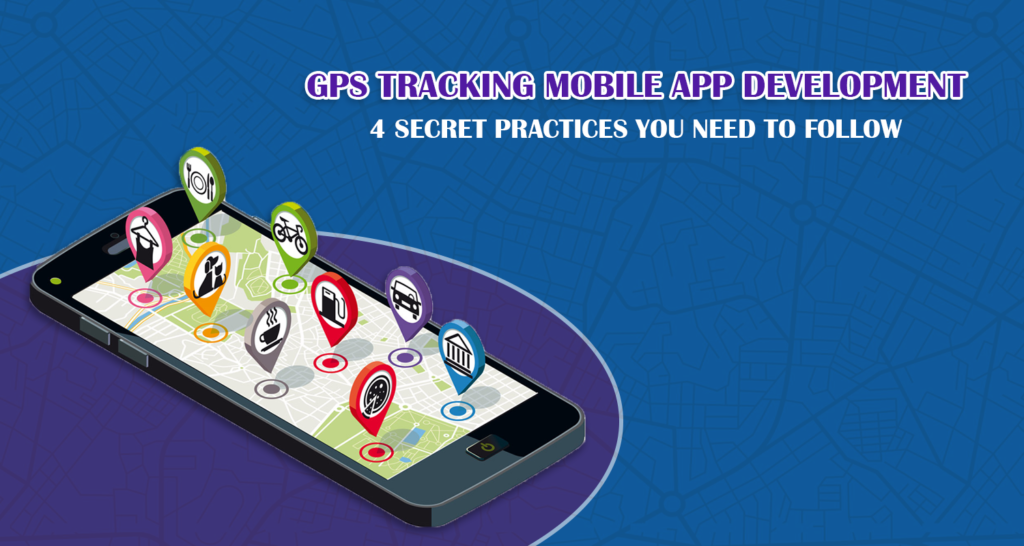GPS Tracking Mobile App Development- 4 Secret Practices You Need to Follow.
Every day, millions of mobile applications get published on the app stores. These apps usually come up with the capabilities of location tracking. However each GPS tracking mobile app is unique, the process of GPS tracking application development is standard. The GPS tracking app development process is parted into four stages: includes pre-design, market research, wireframing, and development

Let’s go through the step-by-step GPS tracking mobile app development process-
Finding the Purpose of GPS Tracking Mobile App
Before starting the process of GPS tracking app development, you need to find out the key purpose of the app. Such tracking applications are used to find out the current location of the user and position on the map. This data is also used in arrays of ways across sectors.
Here are the different purposes of GPS tracking apps:
GPS tracking applications are used for determining the performance and efficiency of remote staff. These have the abilities of time tracking abilities which keep a tab on their movements for the meeting of clients and fieldwork. They can see the recent location and history of the route on a virtual map to assure the productivity and safety of the remote employees.
Location-based applications are usually used to streamline fleet management processes. GPS tracking mobile app development with routing and mapping capabilities can help employers to keep track of drivers, enhance safety and safeguard all the assets. These apps provide location data and help drivers to navigate with ease. They can also help to create reports and in case of any emergency, they issue warnings.
One can also develop a GPS-powered application for fitness and sports enthusiasts. Such apps can help them in organizing their daily routes, see their location activities, track the value of distance, speed, steps, and burn calories.
You can also develop a GPS Tracking system for sports and fitness enthusiasts. Such apps will help to organize their daily routes, track the value of distance, see their location, activities, speed, steps, and burn calories.
Market Research
The development of GPS tracking mobile apps is not as easy as it appears. For the successful launch of GPS tracking mobile app development, it needs a lot of effort. According to a study, the commercial success of mobile applications was 0.01 percent in 2018. It means that only one out of 10,000 applications was successful. The main reason behind the failures of apps is improper and inadequate market research. After figuring out the purpose of GPS tracking app development, now it is time to do market research.
Here are some pointers to bear in mind:
Competitor Analysis:
Evaluate the competitors and make a list of all the pros and cons of applications of competitors. Analyze and figure out how you can differentiate your product.
Interview the Prospects:
Contact directly with the users of the applications and analyze their pain points. Ask them questions and see if your app can resolve the problems.
SWOT Analysis:
Find the good points of apps and things that can improve the app. Find out the factors that can influence the customer base of apps.
Evaluate the Results:
Evaluate the result from primary market research and improve the idea of the initial app.
Creating the Wireframe
Wireframe constitutes a key part of the GPs tracking app development lifecycle. It allows the development team to present their vision to the client and finalize the technology and design.
The wireframe is the most important part of GPS tracking app development. Wireframe allows the development team to showcase their vision to the client and take the final decision of technology and design.
Here is how a wireframe is prepared:
Drafting the Wireframe:
After the mapping of target users and selection of the right tools, developers start to draft the wireframe. Drafting allows outlining the app idea without going into the intricacies.
Testing the Wireframe:
Before the shipment of the wireframe, it becomes very important to do the testing of the design and find out the accuracy of each element. You can also do testing after the creation of a prototype.
Creating a Prototype:
After the creation and testing of the draft, developers can start progressing to the prototype. However the wireframe consists of sets of text and boxes, a prototype is more interactive. They are essential to ensure the successful delivery of applications.
GPS Tracking App Development
The interactive wireframe allows users to see the screens, navigation, visual designs, of the application. After the wireframe is approved, the development of a GPS tracking mobile app starts. In the end, a build gets rolled out internally. For the testing of all the features and functions of the app, the QA team is responsible. If any issue is detected, immediate modifications are made to make the improvement. The testing is done to ascertain its compatibility, security, usability, and performance. The testing is done on different operating systems and devices to ensure uniformity.
After the development, most of the GPS-based mobile apps follow a similar process of app development. With the right planning, resources, tools, and research, you can transform your app idea into a successful solution that will serve customers for years to come.
Nowadays, a number of modern mobile apps use the features of location tracking to improve app performance. GPS tracking app development is very popular among industries concerning food delivery, logistics, banking, retail, and transport services. Building GPS tracking apps involves a number of processes and steps. However, it is very important to anticipate the challenges and figure out the best way to get involved in the market.
